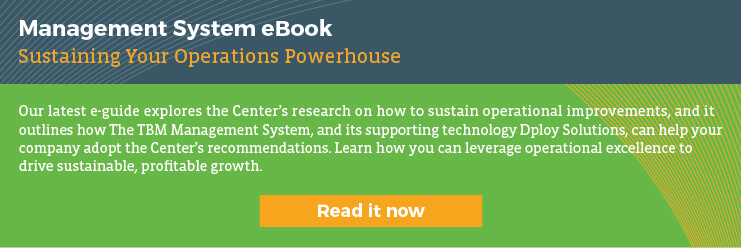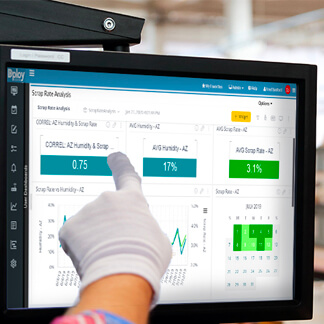4 Operational Subsystems Are Key to Breakthrough Performance
According to research by the National Center for the Middle Market and Dr. Peter Ward, a professor of operational management at The Ohio State University Fisher College of Business, the majority of mid-sized and larger companies have trouble sustaining operational improvements long-term. The reasons why vary: They can range from leadership turnover to inability to access and make use of performance data. (Read this post to learn more about specific issues that can derail operational improvements). But whatever the problem, inability to sustain gains makes it a big challenge to meet profitability and growth goals.
So, what’s a manufacturer to do? The Center’s research report recommends breaking operations into four subsystems: the Strategic Subsystem, the Daily Management Subsystem, the Problem-Solving Subsystem, and the People Development Subsystem. By improving each of these subsystems individually and in concert, the Center contends that organizations will be in a much better position to sustain operational gains.
And at TBM, we couldn’t agree more. In fact, the TBM Management System—our formalized, systemic, and proven approach to operational improvement—provides companies with processes, systems, and tools that can be used to drive specific improvements in each of the subsystems the Center has identified.
Here’s an overview of the Center’s four subsystems, and how the TBM Management System can help companies address each one:
Subsystem 1: The Strategic Subsystem
The Center’s research shows that most companies have trouble translating their strategic vision so that it is relatable and understandable to people in operations. Sometimes, leaders and employees don’t know the big picture, let alone how their roles relate to it. And that can significantly hamper a company’s ability to pursue projects and make decisions that further the organization’s mission.
The TBM Management System helps solve this problem by translating strategic vision and annual objectives into executable plans with achievable daily milestones. The Management System is specifically designed to help you connect big picture strategy to day-to-day goals and objectives and align leaders and employees across and throughout the business around the same efforts. Essentially, it helps you focus your entire organization on a common set of business-critical measures so everyone knows what work to do, and what to measure, to stay on track and achieve strategic objectives.
Subsystem 2: The Daily Management Subsystem
Research by the Center reveals a widespread failure on the part of many companies to use the fundamental elements of an effective daily management system. Companies lack visual controls, an accountability structure, and leader standard work that is needed to stay on top of and achieve daily goals, which are ultimately the key to reaching annual goals.
The TBM Management System makes it easy for firms to put these elements of daily management into place. It provides the process rigor and discipline necessary to make setting goals, measuring progress, identifying misses, and course correcting in real time part of the daily routine. Companies get in the habit of meeting or exceeding daily goals that link directly to annual operating plans and higher-level initiatives.
Subsystem 3: The Problem-Solving Subsystem
Typically, what makes or breaks a company’s success isn’t so much a problem itself, but how the company responds to that problem. Yet, the Center’s report shows that few companies have a systematic approach to solving problems: Just one in five companies strongly agrees that it has an established, go-to approach for addressing issues.
Problem-solving discipline is central to the TBM Management System. By making problems immediately apparent and giving operations staff at all levels tools to quickly implement solutions while searching for and correcting root causes, the TBM Management System helps establish a powerful culture of motivated problem-solvers. So your business will know how to keep operational improvements going, no matter what gets in the way.
Subsystem 4: The People Development Subsystem
The best tools, technologies, and systems are only as good as the people using them. And too often, leaders lack the skills sets to maximize the contributions of every team member. Training managers to be effective coaches and mentors is the key to real employee empowerment, mobilization of the entire workforce, and improved accountability across the board. Yet, the Center’s research shows that Just 11% of mid-sized firms and 14% of larger companies strongly agree that all leaders in their organization receive training on how to coach.
The TBM Management System offers managers new ways to coach and develop associates. It helps train leaders to take the reins and foster an environment where everyone is fully engaged in solving problems, making ongoing improvements, and driving an organization toward its strategic goals.
Formalize Your Approach to Operational Excellence to Sustain Your Gains
The Center’s research makes the case for a clear, formalized approach to improving operational performance. And it shows how, by focusing on four operational subsystems, companies can sustain the gains they make.
The TBM Management System can help companies put the Center’s recommendations into practice to drive sustainable, profitable growth. To learn more about what the research shows and how the TBM Management System works.





